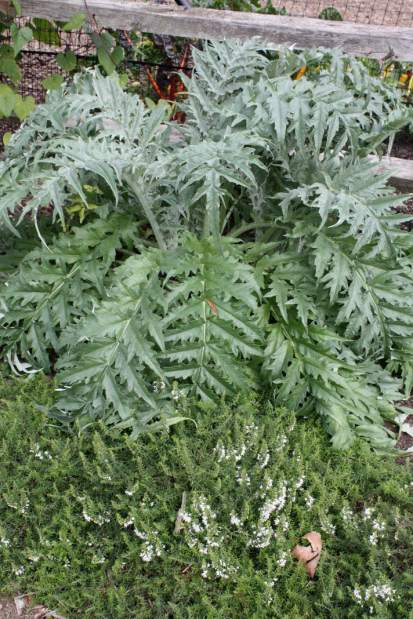Garden Q&A: Monstrous cardoon worth bringing into vegetable plot
Question: I visited a public garden in Philadelphia last summer and came across an enormous plant I was told was called cardoon. It was spiky and silvery in color with no flowers. The person giving us the tour said it was edible, too. Is this something I can grow in my vegetable garden? Is it worth it?
Answer: Cardoon ( Cynara cardunculus) is a wild version of the artichoke. Rather than eating the flower bud, as one does with an artichoke, the leaf stalks are consumed (though the flower buds also are edible). They can be blanched, sauteed or used in soups and stews like celery. In Italy, the stalks often are eaten with a hot garlic and anchovy dipping sauce.
Cardoon grows up to 5 feet in height, though here in Pennsylvania it is more likely to reach only 3 or 4 feet. Still, it is a striking garden specimen. The leaves are covered in fine, silvery hairs, are deeply serrated and are sprinkled with prickly spines. The flowers look much like giant purple thistles and are magnets to butterflies and bees of all sorts. If you plan to use cardoon in the kitchen, you'll want to seek out a near-spineless cultivar (“Gigante,” for example).
Cardoons require a very long growing season (upward of 90 days if possible). To grow them, sow seeds indoors under lights in late March and plant seedlings outdoors as soon as the danger of frost has passed.
Because the plants grow so large, give them plenty of room. Allow them to grow throughout the summer. Come fall, bunch the stems together, using gloved hands, and wrap the entire plant in cardboard or newspaper tied tightly with twine. This will blanch the stalks and soften both their color and texture. Allow the cardboard to remain in place for several weeks before harvest.
Though the plants are only hardy to zone 7, I do know some local gardeners who have luck over-wintering the mature plants by covering them with a “tent” of fencing filled with straw. Because it is a perennial, cardoon can return for several years if given adequate protection from winter temperatures.
Horticulturist Jessica Walliser co-hosts “The Organic Gardeners” at 7 a.m. Sundays on KDKA Radio. She is the author of several gardening books, including “Attracting Beneficial Bugs to Your Garden: A Natural Approach to Pest Control” and “Good Bug, Bad Bug.” Her website is www.jessicawalliser.com.
Send your gardening or landscaping questions to tribliving@tribweb.com or The Good Earth, 503 Martindale St., 3rd Floor, D.L. Clark Building, Pittsburgh, PA 15212.

